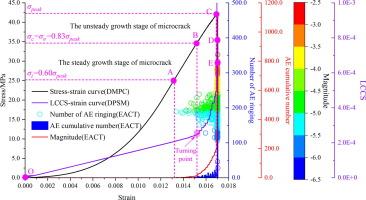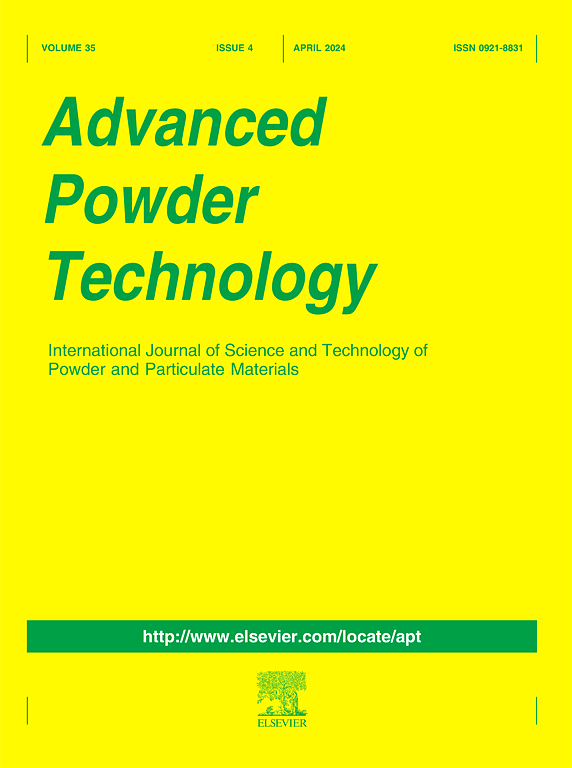Particle flow numerical simulation study on fracture nucleation in red sandstone considering initial nonlinear deformation
IF 4.2
2区 工程技术
Q2 ENGINEERING, CHEMICAL
引用次数: 0
Abstract
This study systematically explores the evolution of microcracks and localized nucleation characteristics in red sandstone under uniaxial compression using Particle Flow Code (PFC) integrated with innovative numerical simulation techniques. To address the inherent nonlinear deformation behaviour of rock during initial loading stages, a novel dual-stage modulus matching parameter calibration method was proposed. This method effectively reproduces the complete stress–strain process of red sandstone under uniaxial loading. Furthermore, the acoustic emission (AE) characterization technique in PFC was enhanced through optimizing spatiotemporal clustering criteria and localization algorithms for microcracks. The rationality of this approach was validated by analysing AE energy characteristics and the correlation between microcracks and macroscopic fractures. To accurately identify the spatial distribution and threshold stress of microcrack nucleation, a full-field synergistic strain calculation method and local strain concentration coefficient (LSCC) for PFC based on digital image correlation (DIC) were proposed. The results demonstrate that strain information exhibits higher sensitivity compared to fracture information, and the LSCC effectively identifies threshold stresses corresponding to microcrack nucleation and rock failure. The novel PFC methodologies proposed in this study advance numerical simulation techniques and offer valuable insights into the evolution, nucleation, and failure mechanisms of microcracks in rocks.

考虑初始非线性变形的红砂岩裂缝成核颗粒流数值模拟研究
利用颗粒流程序(PFC)和创新的数值模拟技术,系统地研究了单轴压缩条件下红砂岩微裂纹的演化和局部成核特征。针对岩石初始加载阶段固有的非线性变形特性,提出了一种新的双阶段模量匹配参数标定方法。该方法有效再现了红砂岩在单轴加载下的完整应力-应变过程。此外,通过优化微裂纹的时空聚类准则和定位算法,增强了PFC中的声发射表征技术。通过分析声发射能量特征和微裂纹与宏观裂纹的相关性,验证了该方法的合理性。为了准确识别微裂纹成核的空间分布和阈值应力,提出了一种基于数字图像相关(DIC)的PFC全场协同应变计算方法和局部应变集中系数(LSCC)。结果表明,应变信息比断裂信息具有更高的敏感性,LSCC能有效识别微裂纹成核和岩石破坏对应的阈值应力。本研究提出的新型PFC方法促进了数值模拟技术的发展,并为岩石微裂纹的演化、成核和破坏机制提供了有价值的见解。
本文章由计算机程序翻译,如有差异,请以英文原文为准。
求助全文
约1分钟内获得全文
求助全文
来源期刊

Advanced Powder Technology
工程技术-工程:化工
CiteScore
9.50
自引率
7.70%
发文量
424
审稿时长
55 days
期刊介绍:
The aim of Advanced Powder Technology is to meet the demand for an international journal that integrates all aspects of science and technology research on powder and particulate materials. The journal fulfills this purpose by publishing original research papers, rapid communications, reviews, and translated articles by prominent researchers worldwide.
The editorial work of Advanced Powder Technology, which was founded as the International Journal of the Society of Powder Technology, Japan, is now shared by distinguished board members, who operate in a unique framework designed to respond to the increasing global demand for articles on not only powder and particles, but also on various materials produced from them.
Advanced Powder Technology covers various areas, but a discussion of powder and particles is required in articles. Topics include: Production of powder and particulate materials in gases and liquids(nanoparticles, fine ceramics, pharmaceuticals, novel functional materials, etc.); Aerosol and colloidal processing; Powder and particle characterization; Dynamics and phenomena; Calculation and simulation (CFD, DEM, Monte Carlo method, population balance, etc.); Measurement and control of powder processes; Particle modification; Comminution; Powder handling and operations (storage, transport, granulation, separation, fluidization, etc.)
 求助内容:
求助内容: 应助结果提醒方式:
应助结果提醒方式:


